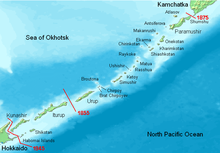91st Division (Japanese Empire)
|
91st Division |
|
|---|---|
| active | April 12, 1945 to September 1945 |
| Country |
|
| Armed forces |
|
| Armed forces |
|
| Branch of service | infantry |
| Type | division |
| Strength | approx. 20,000 |
| Insinuation |
27th Army 5th Regional Army |
| Location | Paramushiru |
| Nickname | Saki-heidan ( 先 兵 団 , "advance division") |
| Butcher | Pacific War |
The 91st Division ( Japanese 第 91 師 団 , Dai-91 Shidan ) was a division of the Imperial Japanese Army , which was set up and disbanded in 1945. Your Tsūshōgō code (military code name) was advance division ( 先 兵 団 , Saki-heidan ) or Saki 12600 or Saki 12640 .
History of unity
The 91st Division was on 12 April 1945 under the command of Lieutenant General Tsutsumi Fusaki ( 堤不夾貴 ) on the eastern Kuril Islands set up and consisted mainly of the 73rd and 74th Infantry - Brigade with six infantry battalions and the 11 2nd Panzer Regiment and 2nd Independent Panzer Company. Initially equipped with an anti-aircraft unit of regimental strength, this was reduced to an 840-strong battalion in mid-1945. The approx. 20,000 strong division was under the 27th Army , from February 1, 1945 directly under the 5th Regional Army .
Until mid-1945, the 91st Division defended the Kuril Islands together with the 42nd Division until it was moved to Hokkaidō . Since the Japanese feared to be exposed to an American landing, defensive positions with bunkers , gun emplacements and trenches were created, which dominated potential landing sections.

In the neutrality pact between Japan and the Soviet Union of April 13, 1941, both contracting parties entered into a commitment to respect the mutual territorial integrity and inviolability. On April 5, 1945, the Soviet Union announced that it would no longer renew the contract, so that it would become invalid on April 25, 1946. On August 8, 1945, the Soviet Union declared war on Japan and began a large-scale offensive ( Operation Auguststurm ), initially on the Asian continent. On August 18, 1945, at 4:30 a.m., Soviet marines crossed the narrow waterway from Kamchatka to Shimushu Island, on which the 91st Division was located. The Soviet marines used 16 American LCI (L) - Landing Craft, Infantry (Large) for the landing, each bringing about 180 men 10 knots to the landing target. Even so, the taking of Shimushu claimed the lives of 1,567 Soviet and 1,018 Japanese soldiers by August 21, just days before the end of World War II .
Tokyo Army Headquarters allowed the commanding general of the 5th Regional Army to negotiate surrender, which took place for the garrisons on Shumushu , Paramushiru and Onekotan on the evening of August 19.
In September 1945 the 91st Division was disbanded.
structure
On April 12, 1944, the formation of a Type C "Special" or "Brigade" division took place as follows:
- 91st Division Staff (476 men)
- 73rd Infantry Brigade Staff (89 men)
- 282nd Independent Infantry Battalion (858 men)
- 283rd Independent Infantry Battalion (858 men)
- 284th Independent Infantry Battalion (858 men)
- 285th Independent Infantry Battalion (858 men)
- 286th Independent Infantry Battalion (858 men)
- 287th Independent Infantry Battalion (858 men)
- 73rd Infantry Brigade Telecommunication and Signaling Unit (271 men)
- 73rd Infantry Brigade Engineer Unit (157 men)
- 74th Infantry Brigade Staff (89 men)
- 288th Independent Infantry Battalion (858 men)
- 289th Independent Infantry Battalion (858 men)
- 290th Independent Infantry Battalion (858 men)
- 291st Independent Infantry Battalion (858 men)
- 292nd Independent Infantry Battalion (858 men)
- 293rd Independent Infantry Battalion (858 men)
- 74th Infantry Brigade Telecommunication and Signaling Unit (271 men)
- 74th Infantry Brigade Engineer Unit (157 men)
- 11th Panzer Regiment (561 men)
- 2nd independent tank company (94 men)
- 91st Division, 1st Artillery Unit (1251 men)
- 91st Division, 2nd Artillery Unit (945 men)
- 91st anti-aircraft unit (2511 men)
- 91st anti-tank unit (419 men)
- 91. Telecommunication and signaling unit (328 men)
- 91st Engineer Unit (767 men)
- 91st Transport Unit (284 men)
- 91st supply unit (201 men)
- 91st Medical Unit (169 men)
- 1. Kuril Hospital (317 men)
- 73rd Infantry Brigade Staff (89 men)
Total strength: approx. 19,772 men
See also
Web links
- 師 団 Ⅰ. Organization of IJA Divisions, accessed January 2, 2015 (Japanese).
- Kurile Islands (Kuril). PacificWrecks.com, accessed May 9, 2015 .
literature
- John Underwood: The Japanese Order of Battle in World War II. Vol I, The Nafziger Collection, Inc., 1999, ISBN 978-1-58545-044-2
- Victor Madej: Japanese Armed Forces Order of Battle 1937–1945. Volume I + II, Game Marketing Company, 1981
- Leland Ness: Rikugun: Guide to Japanese Ground Forces 1937-1945. Helion & Company Ltd, 2014, ISBN 978-1-9099-8200-0